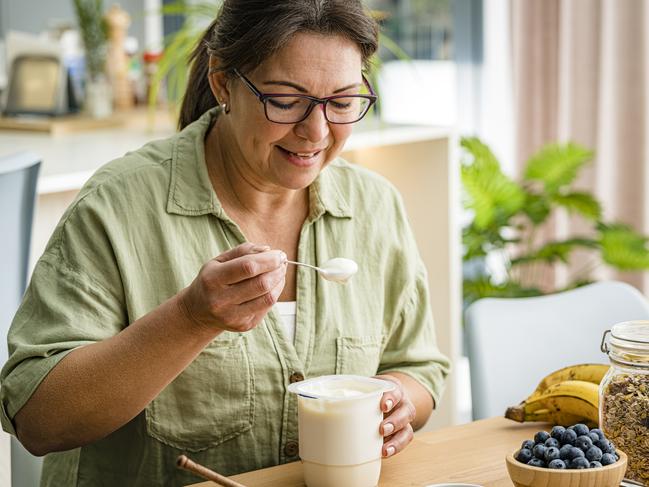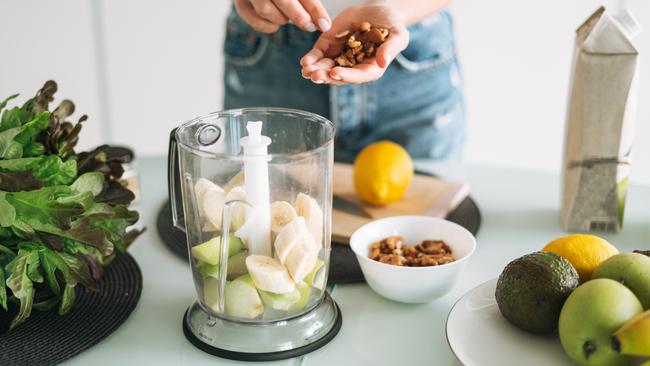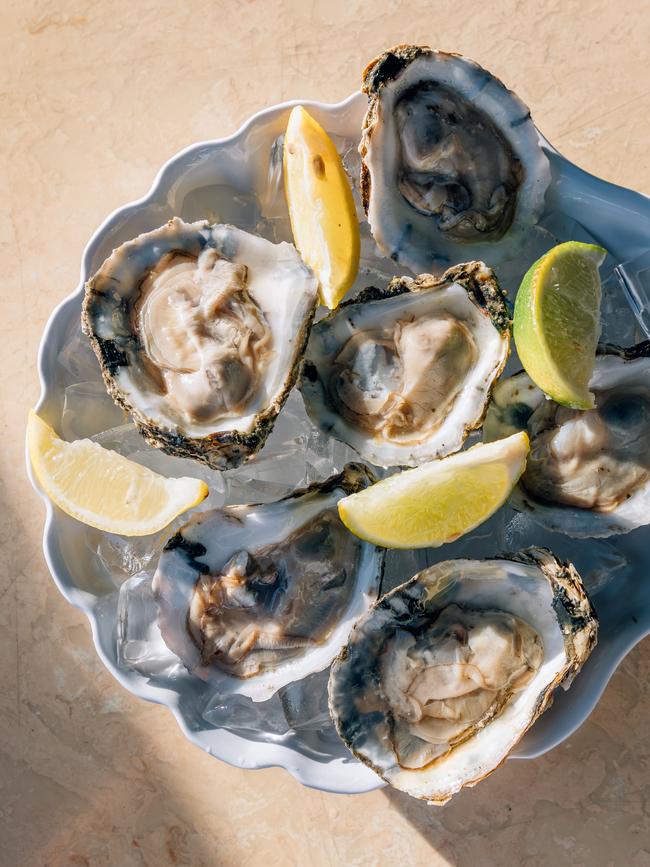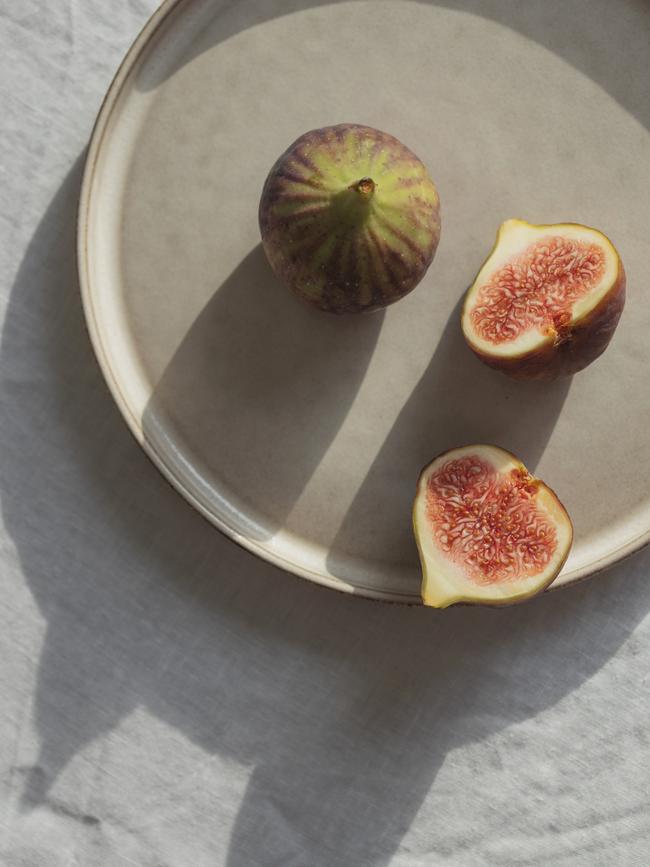Think your body shape is changing in menopause? It’s not your imagination
As women transition into perimenopause and menopause, they may notice a change in their body shape and how they feel. Here’s what some experts say will help keep you nourished.

If you’ve noticed a shift in your body shape around the time of menopause, you’re not alone. Those years of transition can trigger multiple physiological changes both inside and out.
Suddenly, you may notice some extra padding around your belly, or a decrease in muscle tone, or your body won’t quite respond to food and exercise like it did previously. Your ability to exercise might even be affected by a feeling of flatness or exhaustion. Sometimes, these changes can affect your wellbeing.
Part of the cause could be the fluctuating hormones of perimenopause and then their drop during menopause.
“A decline in oestrogen does actually cause an accumulation of fat to come around the middle,” said Sandra Villella, a consultant naturopath and herbalist affiliated with Jean Hailes for Women’s Health.
That transition also makes it harder for your body to control sugar levels, which can be problematic for some people.
“We go from being a pear to a bit more like an apple,” Ms Villella said. “The extra fat around the middle can have a bit more of a tendency of what we call insulin resistance, so we don’t actually get our blood sugar behaving quite the same way as it used to. If there’s a lot of fat accumulation, that’s problematic because it increases the risk of type 2 diabetes and cardiovascular disease.”
According to the British Heart Foundation, when oestrogen levels drop, fat can also build up in the arteries and cause them to narrow which can increase a person’s risk of developing coronary heart disease, a heart attack, or stroke.

Megan Rebuli is a research dietitian with the national science agency, the CSIRO, and said those changes could also affect hunger.
“Oestrogen has a really important role all around the body,” Ms Rebuli said. “It does so many things, it’s involved in a lot of cycles, including in our liver, in our muscles, in our gut.
“Appetite could potentially increase a little bit and there are changes in the way the body handles cells and there can be a lifestyle change as well.”
Those lifestyle changes can include the pressures that come with midlife as women balance family and caring responsibilities with a career and general life.
Ms Villella agrees: “A lot of people in their early 50s or late 40s are also mothers, though not necessarily, but they’re working, they’re kind of sandwich parenting – they’ve often got older parents and younger children, and exercise can sometimes drop off and our muscle mass decreases”.
Whatever the cause, what you eat at midlife contributes to your overall health and wellbeing. As discussed previously, women will experience significant changes throughout their body in the lead-up to menopause, including a rapid decrease in bone density. That doesn’t mean women will necessarily feel “off” during menopause, but it is still a good time to consider your health and make improvements, if they’re needed, to ensure your next decades of your life are the best they can be.
“Having protein at every meal is going to support muscle mass, and calcium and vitamin D are really important to support bone mass,” Ms Villella said.
“Generally, we say it should be about point-eight to one gram of protein per kilogram of body weight … if you’re having two eggs for breakfast that’s 12g, and if you’re not having any other protein for the rest of the day, that’s not enough.”
She suggested balancing plant and animal protein and combining that with lots of vegetables to offset any acidity.
“Then, including other vitamins and minerals, like vitamin C is quite important, B vitamins and Omega 3s, so, that’s kind of the nutrient side of it,” Ms Villella said.
Both she and Ms Rebuli recommend the Mediterranean diet as a good starting base. It promotes high vegetable consumption, lean meats, fish about three times a week, healthier desert choices like fruit or nuts in moderation and including olive oil as the main added fat.
“Following a healthy diet is always going to serve you well,” Ms Rebuli said. “Focus on a balance and a variety of foods from all the food groups, and it doesn’t have to be complicated. It’s about finding that healthy diet and using foods that you enjoy as ingredients and making your meals work for you.”

Other foods to prioritise
Wholegrain carbohydrates like oats, quinoa, wholemeal bread and pasta, and brown rice are recommended to help fuel you. Whole carbs have a lower glycaemic index than refined or heavily processed carbohydrates, meaning they break down slower and are less likely to cause your blood sugar to peak then crash, resulting in you feeling fuller for longer. They also typically have more nutrients in them than refined carbohydrates.
Protein is something to prioritise during menopause. Animal protein can come from lean cuts of meat (though, try to limit red meat), eggs, fish and dairy. Plant proteins include seeds, legumes, lentils, hemp, beans and quinoa.
Fish is also good for Omega 3, and both Ms Rebuli and Ms Villella suggested eating fish about three times a week could be helpful. Tinned sardines are particularly good for both Omega 3 and calcium.
Dairy is another element to incorporate into your diet to protect your bones. Sources include milk, natural yoghurt (flavoured yoghurt can have high sugar content), and cheese in moderation.
Sources of non-dairy calcium include chia seeds, soy milk, sheep milk, almonds, kale, broccoli, sweet potatoes, sesame seeds, rhubarb, eggs, those sardines mentioned above, oysters and figs.


Soy is a controversial food, with arguments both for and against it. It is not recommended for some women who have a history of breast cancer, and women may wish to consult a dietitian. However, Ms Villella said there was some suggestion it could help some people with mild vasomotor symptoms related to menopause. She suggested a serving of about 200g, which could include tofu, tempeh and miso. Ms Rebuli agreed it may be helpful for some women, in moderation: “there’s no need to avoid it if you’re kind of healthy, but there’s also no need to go crazy on the soy either.”
Ms Villella had another tip about linseed.
“Freshly ground linseeds are not only a source of fibre, they are a fantastic plant-based source of Omega 3, and we know Omega 3 is good for our heart and our brain; they’re anti- inflammatory and they’re cheap.”
She said a small study suggested the humble seeds might also have other superpowers. “There was a study that some Jean Hailes clinicians did in the late ’90s that (found) it helped to plump up the vaginal cells,” she said. “And so I’ve been kind of prescribing this for years for vaginal dryness, and patients report that it is quite useful. But it’s a great thing to put on cereal as fibre, the Omega 3, and also possibly vaginal health.”
To get the most out of linseed, she suggested grinding a small amount in a spice grinder to activate it before adding it to your foods. And, ladies, Ms Villella kindly let us republish one of her linseed recipes below. We have it on good authority that those in the know colloquially referred to these as “Vagina-Plumping Muffins”.
Products to limit
Limiting alcohol is a big recommendation from both of our experts. Alcohol can increase your risk of developing chronic preventable diseases. Wine, in particular, may also trigger hot flushes and night sweats because of the chemicals it contains. It can also make for a less restful night’s sleep.
Women may also find their vasomotor symptoms of menopause, like night sweats and hot flushes, can also be triggered by caffeine, hot beverages, and spicy food. While women with moderate to severe symptoms may look to medications to help control their symptoms, our experts said reducing these products could also help some women cope with them better.
Fatty foods, refined carbohydrates and sugar were also on the list to avoid or at least try and limit.
Some women in menopause also support fasting. However, our experts urged caution. They said it was important to ensure your body was getting adequate nourishment.





To join the conversation, please log in. Don't have an account? Register
Join the conversation, you are commenting as Logout